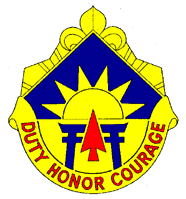
.gif)


Embroidered on wool, 2 1/2" sides

Double colored bullion on black wool; possible mourning detail, 2 1/2" sides

Embroidered on cloth; significance of the dots in center is unknown, 3 1/2" sides

Divisional command staff directed that the patches be worn flat, so some were made as rectangles; embroidered on wool, sides 3" L x 2 1/2" H


Doughboys being doughboys, they rejected the directive, and had round patches made. Wool on wool, 2 1/2" in diameter; note there are 14 rays.

Bullion on velour on wool. 12 irregular rays; 2 3/4" diameter on 3" wool square.

Embroidered on cloth. 16 irregular rays; 2 1/2" diameter on 3" cloth

Wool on wool, small ( 1 7/8" sides) square on armband.


1930s, standard size, on wool

Fully embroidered with OD border

Fully embroidered, no OD border

Embroidered on wool, yellow border, unit designation unknown


Post war Japanese-made, bullion rays, red center (Division Artillery) on wool

Japanese made, embroidered on fine cloth; 11th Ranger Infantry Company, Airborne. Ranger John J. Muñoz states, "We were trained at Fort Benning, GA, and were the first Ranger Company to complete an 8 week course at the Ranger Training Command, then proceeded to Camp Carson, CO for "Mountain and Cold Weather Survival", then proceeded to Japan for full scale amphibious training by the US Marine Corps. The 11th Company was officially inactivated on September 18, 1951. Although the 11th Company did not participated in combat as a company, many of the rangers saw combat in either the 187th Regimental Combat Team, Airborne, or their parent unit, the 40th Infantry Division."

Standard, US-made fully embroidered

Unknown divisional element - possible a scout platoon; Japanese-made, quilted, bullion border, letters "JAPAN"; has Indian figure on sun


One piece Ball of Fire patch and scroll; embroidered on twill.

40th Infantry Division (NGUS) reserve cadre, fully embroidered. Worn by those National Guardsmen who remained behind in California and were not sent to Japan with the division.
